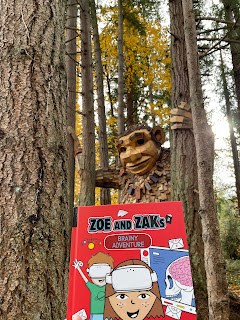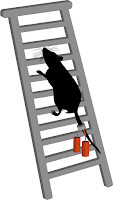My first book will be "It depends." Anyone whose gone through PT School - or probably any professional medical education - will likely tell you stories of how they asked questions in school only to be repeatedly told, "it depends." Though frustrating, with the hindsight of a decade of clinical practice, it's now a lot easier to recognize that this is the best answer, and now I can come up with a whole host of considerations that the question would depend on. This is a chance to tell some clinical stories to shed light on why working in healthcare is so complex, and also highly entertaining. So hopefully I'll be able to write the book while keeping up with my blogging!
Early in 2024, I was invited to give some talks at different conferences, so I dedicated the early part of the year to a lot of reading and developing those presentations. The biggest talk was alongside colleagues Dr. Karen Litzy and Dr. Devra Sheldon at the American Physical Therapy Association Combined Sections Meeting in Boston about Complex Regional Pain Syndrome. I also spoke at the TRIA Orthopedic and Sports Medicine Conference in Minneapolis about Rehabilitation for the Adolescent Athlete thanks to an awesome colleague recommending me for the job. In 2025, I'm working on giving a talk at the Seattle Children's Hospital Rheumatology Conference where I'm partnering with a physician and we're talking about differentiating between rheumatological conditions and chronic sport-related pain in young athletes.
My writing in 2024 was limited, but looking back it was all fun. I wrote three articles for The Next Hoops and some blog posts for Pain Geeks. The Next publishes everything you could ever want to read about women's basketball. They're fantastic. If you're a fan of the WNBA or any college team, I highly recommend you check them out and subscribe. My articles for them included coverage of last year's Apple Cup where University of Washington played Washington State University, something that will be more difficult to achieve as the college conferences were realigned heading into this current season.
I also teamed up with fellow physical therapist and writer Lucas Seehafer where we reviewed the 2023 WNBA injury stats heading into the 2024 season. I'm excited to continue to partner with Lucas in the future as more data is collected and hope that next year, the League manages to stay healthier!
My final piece for The Next was an exploration of how the WNBA medical staffs have been expanding as the League has been growing. It included spotlights on several of the medical providers around the League. It gave me a chance to meet new athletic trainers, physical therapists, and strength coaches working in the WNBA as well as to catch up with some of the providers I have known for more than 15 years. They're an awesome group of people and it was really fun giving them the spotlight, though most of them are pretty happy being behind the scenes.
For Pain Geeks, I was invited to lead their fall book club discussion choosing the book, "When Breath Becomes Air" by Paul Kalanathi. For this I wrote two blog posts leading up to the meeting. Part 1 and Part 2. The book is gut wrenching and heart breaking while simultaneously beautiful and inspiring. I rarely read books twice, but I really felt that this one deserved discussion and it was fun chatting about it with the other Pain Geeks. PT pals - if you're working with patients experiencing chronic pain and want to really grow your community of medical providers, the Pain Geeks are all over the world and our group meetings continue to make me a better clinician. Check them out.
I guess since I've mentioned a book I loved in 2024, I'll also write about what I read last year. Thanks to audio books, I broke personal records completing 76 books! Incorporating a bit more fiction seems to make me read faster, and I read more of those than usual because several people kept telling me to jump into Sarah J. Maas's books. Let me just get this out of the way: I liked the "A Court of Thorns and Roses" Series. I did not like the "Throne of Glass" series and didn’t finish it. I like other genres far more than these and don't know if I will read any romantasy in 2025... but if that's your jam, please do enjoy it! I can already feel the daggers coming from some of my friends who thought these books were life changing. Sorry, friends!
What books did I like the best in 2024?
I listened to several biographies or memoirs and also read a few. In a lot of cases, the narrator was also the author and I love when that happens. Incredible athletes like A’Ja Wilson who shared her relationship with her grandma alongside her basketball journey made me want to root for her even though she’s not on the team I cheer for. I felt like The Terminator was sitting in the car right next to me as Arnold Schwarzenneggar described his childhood and how he ended up in body building. It was so much better than hearing my own internal monologue. Dancer/actress Kelly Bishop’s tales of her life and career on stage as the main character in A Chorus Line before she became Emily Gilmore, matriarch in Gilmore Girls. I learned a lot and as a Gilmore Girls fan was so glad she read it herself. My heart broke learning about Britney Spears and how she was basically tortured by her parents and also hearing Matthew Perry describe his ongoing battles with drugs. And there were several others that were all really fantastic, but these were the most memorable from that genre.flying faeries was fun for a while. I think my brain needed somewhere to chill out after all the journal articles and novels helped me recover. My favorite non-fictions this year came from Emily Henry and Taylor Jenkins Reid and I've been working my way through another Greg Iles book that's super long but I love his work. I also liked, "Everyone in my family has killed someone" by Benjamin Stevenson.And my favorite non-fictions this year were "Rare Gems," by Howard Megdal - Minnesota Women's
Basketball History at its finest, "Unreasonable Hospitality," by Will Guidara - which aligns with my commitment to therapeutic alliance with my patients and going out of my way to make others feel special. Though it fits as a memoir, Kate Fagan's "All The Colors Came Out" where she talks about her basketball life along with the relationship it facilitated with her father was perhaps the best book I read all year. Tears and laughter.
So there's 19 of my favorite books from last year... and it was even hard to choose those!
What am I most excited to read in 2025?
Biographies: Maya Moore's Love and Justice and Brittney Griner's Coming Home
Fiction: the new prequel for the Hunger Games that explores the back story of Haymitch - Sunrise on the Reaping - by Suzanne Collins and novels by Abby Jimenez
Non-Fiction: Jay Shetty's 8 Rules of Love and Louis Gifford's Aches and Pains series.
I like to read a classic and/or banned book and this year I think it'll be Brave New World.
Beyond that - here's to lots of fun 2025 travels and meet ups with friends with outings planned in Maui, San Francisco, and Austin already... but more for sure to come. Who wants to get together? Let's make some plans! I'm sure there will be plenty of basketball games to attend, hopefully some more Goo Goo Dolls concerts, and fun adventures around the PNW. Happy New Year, all!


































